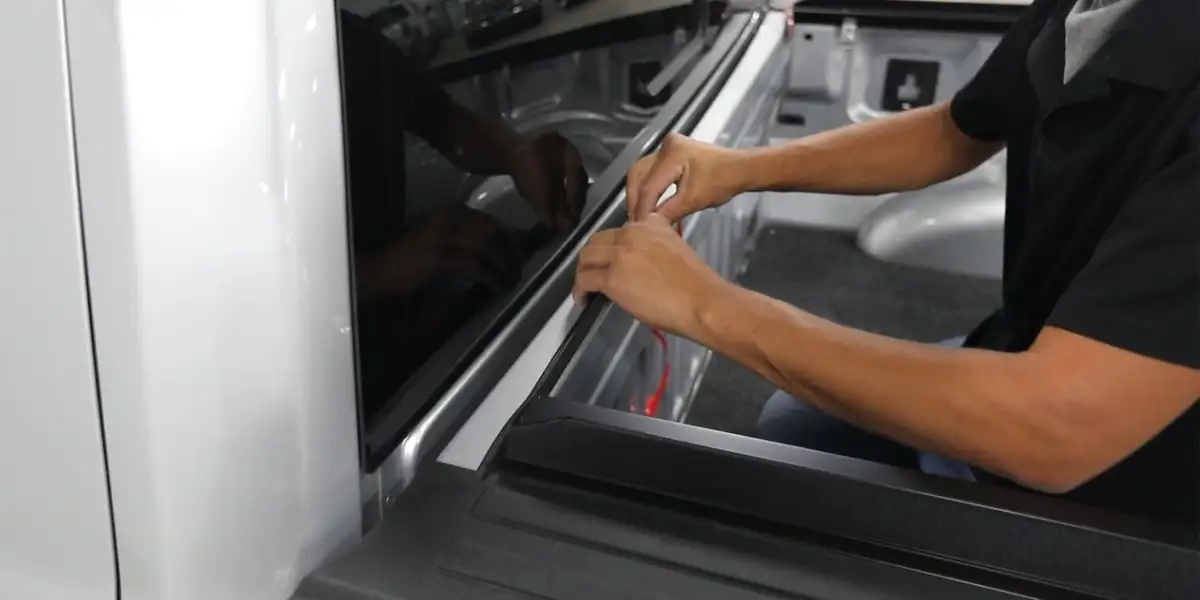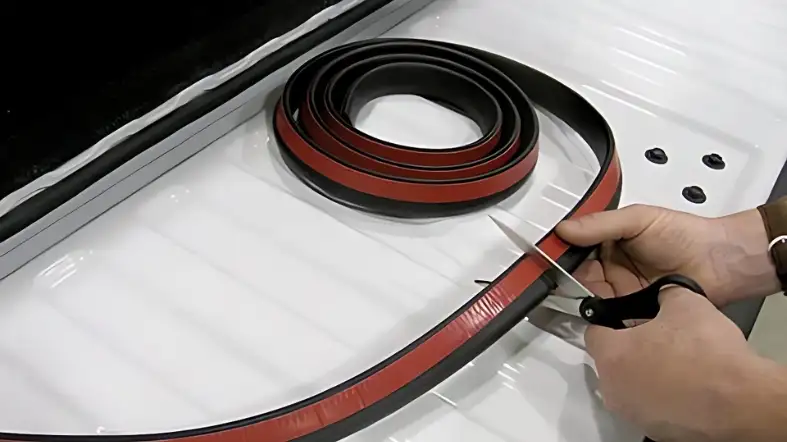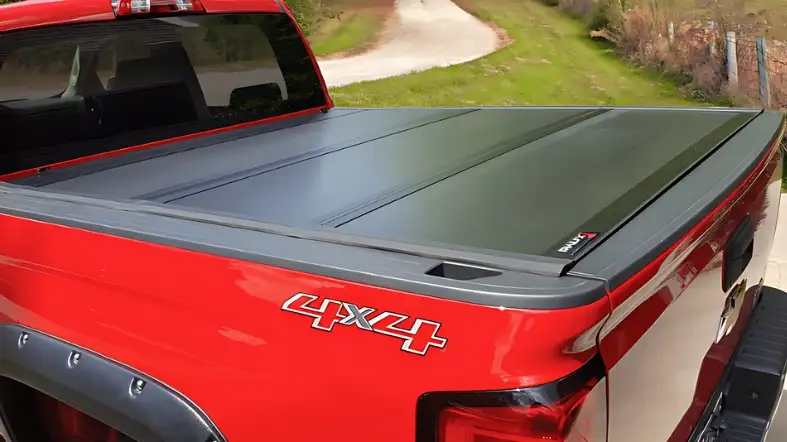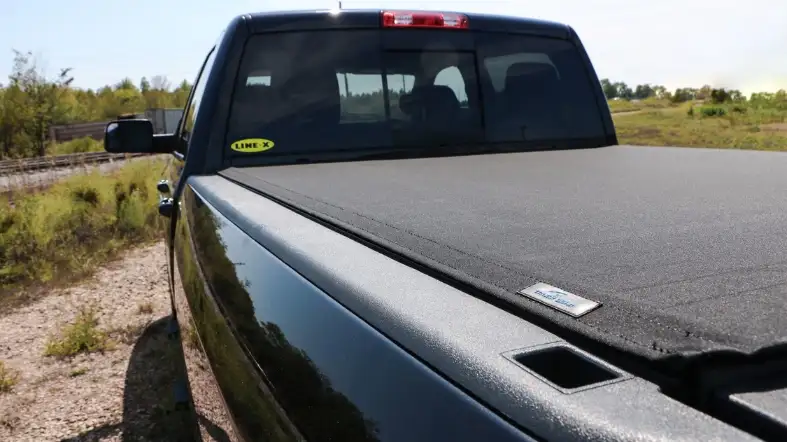Are you struggling to keep your tonneau cover secure and protected? Wondering how to ensure a tight seal for durability?
Look no further! Here we will discuss the process of sealing a tonneau cover.
We will also discuss the importance of proper sealing and different methods. So you don’t miss anything about the tonneau cover.

How do you seal a tonneau cover?
By following these step-by-step instructions, you can seal your tonneau cover:
Step 1
Clean the Tonneau Cover Surface using mild detergent and water. Remove any dirt, debris, or residue that could hinder the sealing process. Be sure to dry it completely before moving on to the next step.
Step 2
Inspect the Seal and Hardware. Look for any signs of wear, damage, or loose components. Replace any worn-out or damaged parts to ensure a tight and secure seal.
Step 3
Measure the length and width of the tonneau cover’s side rails. Cut weatherstripping tape to match these measurements.
Peel off the adhesive backing and carefully apply the tape along the side rails, ensuring a snug fit.
Step 4
To prevent water from entering through the tailgate, install a tailgate seal. Measure the length of the tailgate and cut the seal accordingly.
Apply it to the inside edge of the tailgate, creating a barrier against moisture and debris.
Step 5
Most tonneau covers come with adjustable tension systems. Follow the manufacturer’s instructions to adjust the tension.
This helps ensure a tight fit and prevents the cover from sagging or flapping during travel.
Step 6
Once you’ve completed the sealing process, it’s essential to test the effectiveness of the seal.
Close the tonneau cover and spray it with water from a hose. Inspect the interior for any signs of leakage.
If you notice water entering, identify the problem area and make necessary adjustments.
Step 7
To maintain a proper seal, clean the tonneau cover and inspect the seal for any wear or damage.
Replace worn-out weatherstripping tape or seals promptly to ensure continued protection.
Step 8
Depending on your needs, you may want to consider additional accessories to enhance the sealing of your tonneau cover.
These can include tailgate gaskets, clamps, or even a tonneau cover cleaner and protectant.
Types of Tonneau Cover Sealing Methods

Knowing these different tonneaus cover sealing methods, you can find the one that best suits your needs and preferences.
Method 1: Snap-On Tonneau Cover
Snap-on tonneau covers utilize a series of snaps or buttons along the truck bed to secure the cover.
The snaps are typically made of durable materials like stainless steel or nylon, ensuring a secure fit.
To seal the cover, snap the buttons into place along the side rails and tailgate. This is a cost-effective solution for sealing your tonneau cover.
Method 2: Velcro Tonneau Cover
Velcro tonneau covers feature a strip of hook-and-loop fasteners along the edges.
This sealing method allows for easy installation and adjustment, as the Velcro strips securely adhere to each other.
To seal the cover, align the edges and press them together to create a tight bond. Velcro sealing offers convenience, making it a popular choice for tonneau cover owners.
Method 3: Roll-Up Tonneau Cover
Roll-up tonneau covers utilize a series of horizontal support bars or bows that roll up with the cover when opened.
To seal the cover, unroll it over the truck bed and secure it in place using a latching mechanism or fastening straps.
This method provides a tight seal while offering quick and easy access to your cargo. Roll-up covers are known for their durability and weather resistance.
Method 4: Folding Tonneau Cover
Folding tonneau covers consist of multiple panels that fold up to provide access to the truck bed. These panels are connected with hinges, allowing for easy folding and unfolding.
To seal the cover, fold the panels back into place and secure them using integrated latches or locking mechanisms.
Folding tonneau covers offer versatility, as they can be fully opened based on your needs.
Method 5: Retractable Tonneau Cover
Retractable tonneau covers feature a retractable design that allows the cover to slide back and forth along a track system.
To seal the cover, slide it forward to cover the truck bed and lock it in place using the built-in locking mechanism.
Retractable covers offer a sleek and streamlined appearance with excellent security and protection.
Method 6: Hinged Tonneau Cover
Hinged tonneau covers consist of a single solid panel or multiple panels hinged together.
To seal the cover, close the panel(s) over the truck bed and secure them using latches or locks.
Hinged covers offer a secure and rigid sealing option, ensuring optimal protection for your cargo.
Method 7: Clamp-On Tonneau Cover
Clamp-on tonneau covers utilize clamps or brackets to secure the cover to the truck bed.
These clamps are typically adjustable and can be tightened to create a tight seal.
To seal the cover, position it over the truck bed and secure it in place using the clamps or brackets.
Clamp-on covers offer ease of installation and removal, making them a popular choice for truck owners.
Benefits of Properly Sealing a Tonneau Cover

Sealing your tonneau cover offers a multitude of benefits, such as:
Prevent Water Infiltration
When you seal your tonneau cover, you create a barrier that keeps water from infiltrating your truck bed.
By preventing water ingress, you safeguard your belongings from potential damage.
This is beneficial when transporting sensitive or valuable items, ensuring they stay dry and protected.
Preserve Cargo Integrity
A properly sealed tonneau cover helps maintain the integrity of your cargo during transportation.
It shields your items from external elements such as wind, dust, and debris that can cause scratches, dents, or wear.
By keeping your cargo in pristine condition, you can extend its lifespan and minimize the need for repairs or replacements.
Enhance Security
Sealing your tonneau cover not only protects your cargo from environmental factors but also enhances the security of your belongings.
A well-sealed cover acts as a deterrent to potential theft by concealing your valuables from prying eyes.
This added layer of security can provide you with peace of mind when parking your vehicle in public areas or overnight.
Step 4: Improve Fuel Efficiency
Believe it or not, sealing your tonneau cover can contribute to improved fuel efficiency.
When your cover is sealed, it reduces wind resistance and drags while driving.
This streamlined airflow can lead to less energy required to propel your vehicle forward, resulting in potential fuel savings over time.
Sealing your tonneau cover can make your truck more fuel-efficient and reduce your carbon footprint.
Step 5: Maintain Tonneau Cover Longevity
Sealing your tonneau cover helps maintain its longevity. By preventing moisture from seeping into the cover and its components, you reduce the risk of rust, corrosion, and deterioration.
Proper sealing also minimizes wear and tear, prolonging the lifespan of your tonneau cover and saving you money on premature replacements.
Step 6: Reduce Noise and Vibrations
A sealed tonneau cover can significantly reduce noise and vibrations while driving.
The snug fit eliminates rattling and flapping caused by wind resistance, providing you with a quieter and more comfortable driving experience.
Whether you’re cruising on the highway or navigating rough terrain, a sealed tonneau cover ensures a smoother and quieter ride.
Step 7: Enhance Vehicle Aesthetics
In addition to the functional benefits, properly sealing your tonneau cover can enhance the overall appearance of your vehicle.
A sealed cover gives your truck a sleek and streamlined look, improving its aesthetic appeal.
This visual enhancement can boost your pride of ownership and make your vehicle stand out from the crowd.
Step 8: Enjoy Versatility and Convenience
By sealing your tonneau cover, you gain versatility and convenience in accessing your truck bed.
A well-sealed cover allows for easy opening and closing, providing quick access to your cargo whenever you need it.
This convenience is especially valuable when loading or unloading items, saving you time and effort.
Factors to Consider When Choosing a Tonneau Cover Seal

By considering these factors when choosing a tonneau cover seal, you can ensure that you select the right seal for your specific needs:
Durability
When selecting a tonneau cover seal, consider the durable materials. Look for seals made from high-quality materials such as rubber, EPDM (ethylene propylene diene monomer), or PVC (polyvinyl chloride).
These materials offer excellent resistance to weather conditions, UV rays, and wear and tear.
A durable seal ensures long-lasting performance and reliable protection for your tonneau cover.
Compatibility with Tonneau Cover Type
Different tonneau cover types may require specific seal designs for optimal performance.
Consider the compatibility between the seal and your tonneau cover type, whether it’s a snap-on, Velcro, roll-up, folding, retractable, hinged, or clamp-on cover.
Ensure that the seal is designed to fit securely and effectively with your specific tonneau cover, providing a tight and reliable seal.
Ease of Installation
Choose a tonneau cover seal that is easy to install, especially if you prefer a DIY approach.
Look for seals that come with clear installation instructions and require minimal tools or adhesive.
This factor is particularly important if you plan to replace or install the seal yourself. Opting for a user-friendly seal ensures a hassle-free installation process.
Weather Resistance
Consider the weather conditions in your area and select a tonneau cover seal that offers excellent weather resistance.
Look for seals that are specifically designed to withstand rain, snow, extreme temperatures, and UV exposure.
A weather-resistant seal ensures that your tonneau cover remains tightly sealed and protects your cargo from moisture, dust, and other environmental elements.
Maintenance Requirements
Evaluate the maintenance requirements of the tonneau cover seal before making a decision.
Some seals may require periodic cleaning, lubrication, or replacement to maintain their effectiveness.
Consider your willingness and ability to perform regular maintenance tasks to ensure the longevity and performance of the seal.
Price and Value
Take into account the price and value of the tonneau cover seal. While it’s important to consider your budget, prioritize the value and benefits the seal provides.
A high-quality seal may come with a higher price tag but can offer superior performance and durability, saving you money in the long run by minimizing the need for frequent replacements or repairs.
Customer Reviews and Recommendations
Before finalizing your choice, read customer reviews and seek recommendations from other tonneau cover owners.
Real-life experiences can provide valuable insights into the performance, durability, and ease of use of different seal options.
Consider the feedback and recommendations from others to make an informed decision.
Maintaining the Seal on Your Tonneau Cover
You can ensure the longevity and effectiveness of the seal on your tonneau cover if you maintain the seal on your cover. Some tips are:
1. Regular Cleaning
To maintain the seal on your tonneau cover, make it a habit to clean it regularly.
Use a mild detergent and water solution to remove dirt, debris, and grime that can accumulate on the cover and the seal itself.
Gently scrub the surface with a soft brush or cloth, paying special attention to the seal area.
Rinse thoroughly and ensure that the seal is free from any residue or contaminants that may affect its effectiveness.
2. Lubrication
Lubricate the tonneau cover seal to ensure smooth operation and to prevent drying or cracking.
Apply a silicone-based lubricant or a recommended seal conditioner to the seal, following the product instructions.
This helps maintain the flexibility and resilience of the seal, ensuring a tight and reliable seal over time.
3. Inspection for Damage
Regularly inspect the tonneau cover seal for any signs of wear, tear, or damage. Look for cracks, tears, or gaps in the seal that could compromise its effectiveness.
If you notice any damage, consider replacing the seal promptly to ensure continued protection and sealing performance.
4 Adjustments and Realignment
Over time, the tonneau cover and its seal may require adjustments or realignment to maintain an optimal seal.
Check the alignment of the cover with the truck bed and ensure that it closes evenly and securely.
Consult the manufacturer’s instructions to make any necessary adjustments to ensure proper alignment.
5. Protection from Harsh Weather Conditions
Extreme weather conditions can impact the performance of your tonneau cover seal. During periods of extreme heat or cold, take additional steps to protect the seal.
Consider using a tonneau cover protectant or conditioner specifically designed for weather protection.
This can help prevent drying, cracking, or degradation of the seal caused by prolonged exposure to harsh weather elements.
6. Addressing Seal Issues Promptly
If you notice any issues with the seal, such as water leakage or a loose fit, address them promptly.
Investigate the cause of the problem, such as misalignment, worn-out components, or damaged seals.
Take necessary steps to rectify the issue, which may involve realigning the cover, replacing worn-out parts, or installing a new seal if required.
7. Seasonal Maintenance
Consider performing seasonal maintenance on your tonneau cover seal to ensure optimal performance throughout the year.
This may involve a thorough cleaning, lubrication, and inspection before the start of each season to address any potential issues and prepare the seal for changing weather conditions.
FAQs
Can I Use Weatherstripping Tape To Seal My Tonneau Cover?
Yes, weatherstripping tape is a common and effective method to seal a tonneau cover.
Is It Necessary To Clean The Tonneau Cover Before Sealing It?
Yes, it is important to clean the tonneau cover surface before sealing to ensure proper adhesion and effectiveness.
How Often Should I Inspect And Maintain The Tonneau Cover Seal?
Regular inspections and maintenance should be performed, ideally every few months or as needed based on usage and environmental conditions.
What Should I Do If I Notice Water Leakage After Sealing My Tonneau Cover?
If water leakage occurs, check for any misalignments or damaged seals and make necessary adjustments or replacements.
Can I Use A Tonneau Cover Seal Conditioner Or Protectant?
Yes, using a tonneau cover seal conditioner or protectant can help prolong the seal’s life and enhance its sealing performance.
Final Words
Sealing your tonneau cover is an easy process that offers numerous benefits. By sealing your tonneau cover, you can ensure maximum protection.
Regular maintenance, cleaning, and lubrication, help maintain the seal’s effectiveness.
